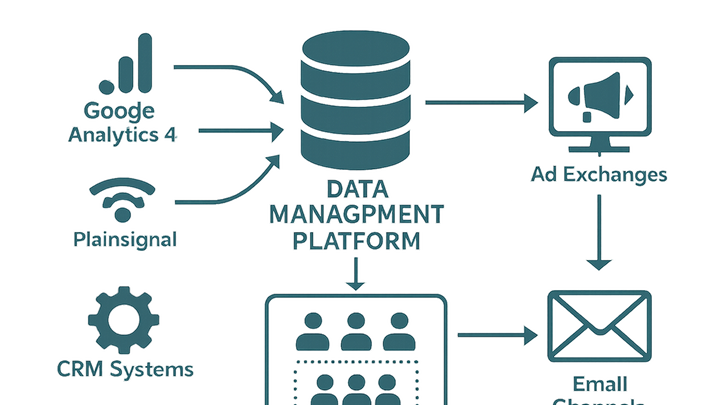Published on 2025-06-22T07:31:01Z
What is a Data Management Platform (DMP)? Examples and Use Cases
A Data Management Platform (DMP) is a centralized system that collects, organizes, and activates large volumes of data from multiple sources.
In analytics and marketing, DMPs unify first-party data (e.g., GA4 events, PlainSignal pageviews) with third-party and offline datasets to build comprehensive audience segments.
These segments power targeted advertising campaigns, real-time bidding, and personalization across digital channels.
DMPs prioritize anonymous or pseudonymized data, ensuring compliance with privacy regulations while delivering actionable insights.
By integrating with analytics platforms like Google Analytics 4 and cookie-free solutions like PlainSignal, organizations can enrich audience profiles and enhance the accuracy of campaign targeting.
Modern DMPs also offer lookalike modeling, frequency capping, and performance analytics, making them essential for data-driven marketing strategies.
Dmp (data management platform)
A DMP aggregates and segments data from various sources for audience targeting and analytics, integrating with GA4 and PlainSignal.
Why DMPs Matter in Analytics and Marketing
DMPs are critical for organizations looking to unify diverse data sources and drive targeted campaigns. They serve as the backbone for audience insights, enabling marketers to understand behaviors, preferences, and intents at scale. Without a DMP, data remains siloed across web analytics tools, CRM systems, and ad networks, limiting personalization and reducing ROI.
By centralizing anonymous and pseudonymous identifiers, DMPs allow for sophisticated audience segmentation and lookalike modeling. This leads to more efficient ad spend, improved retargeting, and a better user experience through relevant messaging.
-
Unified data collection
DMPs ingest data from websites, mobile apps, CRM platforms, and third-party providers into a single repository, offering a holistic view of user interactions.
-
Multiple data sources
DMPs unify web analytics (e.g., GA4), server logs, and offline records to build a comprehensive dataset.
-
Anonymized vs identified data
They primarily operate on hashed or pseudonymous identifiers, focusing on privacy-compliant, aggregated insights.
-
-
Audience segmentation and targeting
Once data is centralized, DMPs enable the creation of granular audience segments based on behavior, demographics, and interests.
-
Behavioral segmentation
Groups users by browsing activity, purchase history, or in-app events to tailor messaging.
-
Lookalike modeling
Generates new user segments that resemble high-value audiences to expand reach efficiently.
-
DMP vs. CDP vs. Analytics Platforms
DMPs, CDPs, and analytics platforms each serve distinct roles in the data ecosystem. Understanding their differences helps organizations choose the right tool for data collection, identity resolution, and activation. While DMPs focus on anonymous audience targeting, CDPs build persistent customer profiles, and analytics platforms provide reporting and event-tracking capabilities.
-
Data management platform (dmp)
A DMP organizes and activates anonymous and pseudonymous data—often cookie-based—for media buying and programmatic advertising.
-
Data longevity
Audience cookies typically expire after six months, limiting long-term tracking.
-
Media activation
Primarily integrates with ad exchanges, DSPs, and retargeting platforms.
-
-
Customer data platform (cdp)
A CDP creates unified, persistent customer profiles by merging first-party identified data across channels.
-
Identity resolution
Links multiple identifiers (email, device ID) into a single customer profile.
-
Cross-channel orchestration
Activates campaigns via email, SMS, in-app messaging, and offline channels.
-
-
Analytics platforms (e.g., GA4, PlainSignal)
These platforms track user behavior—pageviews, events, conversions—and provide dashboards and reports.
-
Event tracking
Captures interactions such as clicks, scrolls, and form submissions for analysis.
-
Funnel analysis
Visualizes user drop-off at each stage of a conversion path.
-
Integrating a DMP with GA4 and PlainSignal
To make the most of a DMP, integrate it with your analytics stack. Syncing segments with GA4 and ingesting data from cookie-free solutions like PlainSignal enhances audience accuracy and expands targeting capabilities.
-
Exporting segments to GA4
Use GA4’s Audience Import API or link your DMP to Google Ads to transfer audience segments for remarketing and conversion tracking.
-
GA4 audiences api
Programmatically push audience lists into GA4, then use them in Google Ads for targeting.
-
Data layer setup
Ensure your website’s data layer captures segment membership before sending hits to GA4.
-
-
Feeding PlainSignal data into the dmp
Incorporate PlainSignal as a server-side data source to enrich your DMP with cookie-free, compliant analytics.
-
PlainSignal tracking code
Use the following snippet to capture pageview and event data:
<link rel="preconnect" href="//eu.plainsignal.com/" crossorigin /> <script defer data-do="yourwebsitedomain.com" data-id="0GQV1xmtzQQ" data-api="//eu.plainsignal.com" src="//cdn.plainsignal.com/plainsignal-min.js"></script> -
Server-side integration
Use your DMP’s ingestion API to import PlainSignal’s aggregated data for segmentation.
-
Best Practices for Implementing a DMP
Adhering to best practices ensures your DMP delivers reliable insights, maintains regulatory compliance, and drives ROI through effective audience activation.
-
Privacy compliance
Ensure all data collection and activation adhere to GDPR, CCPA, and industry-specific regulations.
-
Consent management
Implement a Consent Management Platform (CMP) to capture and store user consents before data ingestion.
-
Anonymization techniques
Hash or pseudonymize personal identifiers to protect user privacy and minimize risk.
-
-
Data hygiene and governance
Maintain high-quality data by standardizing formats, cleaning anomalies, and monitoring data pipelines.
-
Data standardization
Normalize date formats, user IDs, and event names across all sources.
-
Data quality monitoring
Set up alerts for missing, duplicate, or inconsistent data feeds.
-
-
Performance optimization
Continuously evaluate segment effectiveness and system scalability to maximize campaign ROI.
-
Segment performance analysis
Conduct A/B tests to compare segment response rates and refine targeting.
-
Scalability planning
Ensure your infrastructure can handle peaks in data ingestion and query volume.
-
